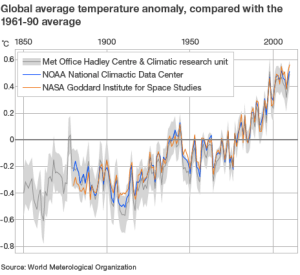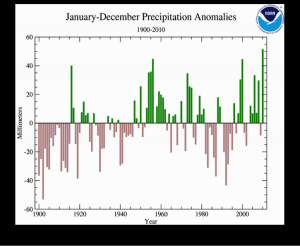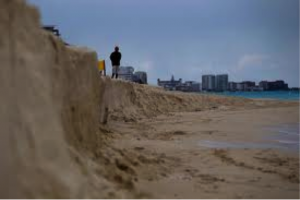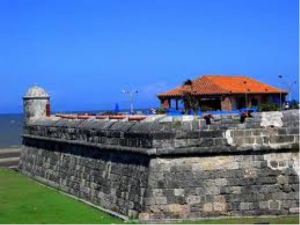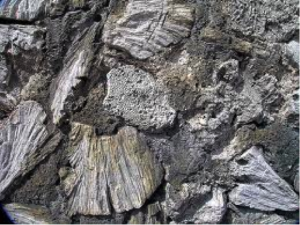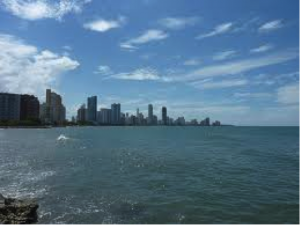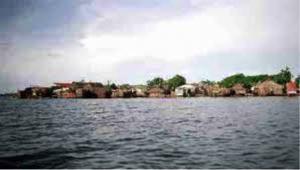January 22 2011
FOOLS’ PARADISES AND CASTLES ON THE SAND:
COASTAL EROSION AND GLOBAL SEA LEVEL RISE
Tom Goreau, PhD
President, Global Coral Reef Alliance
The governments of the world have collectively sentenced coral reefs to extinction from global warming and condemned about a billion people to become refugees from global sea level rise. They signed the death sentence knowingly and deliberately as part of a charade in which they pretended to be in consensus that meeting again in a year to discuss promising to talk again a year later is a substitute for taking real action to solve real problems. And to add insult to injury, they successfully orchestrated a global press campaign to claim that they had somehow “made real progress” in doing so!
They committed this crime against our planet’s life support systems in a Fools’ Paradise, in luxury hotels built like pseudo Maya temples on top of sand dunes and fossil coral reefs that were under the sea the last time in Earth history when temperatures were 1 degree above today’s level. Like sand castles built on a beach at low tide, they will be much deeper under when the waters rise, and even deeper after global temperatures rise the 5 or 10 degrees C that are inevitable from the existing excess of CO2 EVEN IF WE NEVER BURN ANOTHER GRAM OF COAL, OIL OR NATURAL GAS STARTING TODAY. But they chose to ignore those well-established scientific facts, pretending that all these problems really aren’t happening and will just magically disappear if you close your eyes and stop your brain.
Coral reefs are doomed in a few years because governments failed to reverse global warming in Cancun
They enacted this farce in a year that was the hottest year in history (Figure 1), with record heat across the globe, and a year that had some of the most widespread coral death from heat shock, affecting all coral reef areas in the globe except the central Pacific, which was locally cooled due to the La Nina.
2010 was also the wettest year in history (Figure 2), with catastrophic floods all over the world destroying the homes and food of millions of people. That is no surprise at all, because fundamental physical laws say that the warmer it gets the more water evaporates from the ocean, so the more rain we will have, at least on the global average. However, even though most areas will get wetter, this won’t help the interiors of the large continents, which will become drier because most of the rainwater falls near the coast before it gets to remote inland areas, but evaporation of soil moisture increases, causing deserts to spread.
Only one country, Bolivia, took a principled stand against the disaster at the UN Framework Convention in Cancun. That is especially notable because Bolivia is a mountain country with no seashore at all since Chile seized its coastline over a hundred years ago! The first Indigenous President of Bolivia, Evo Morales, spoke out for reversing global climate change, based on the view that their ancient Aymara traditions say we must care for Mother Earth, Pachamama, as the source of our own life. All other nations simply sneered at his naivete, ridiculing him as an ignorant native with a primitive mystical view of nature. After all there are vast fortunes to be made producing and consuming the fossil fuels that are directly causing global warming and global sea level rise.
No matter how much they point their fingers at each other, the Americans, Europeans, Chinese, Indians, Russians, Japanese, Australians, Canadians, and oil producing states were all completely united in wanting no interruption to the profits they are making right now by destroying our planet’s life support systems for future generations. They all work together in complete harmony in closed-door meetings, right after they blame each other in public. And worst of all, they have successfully bribed, mostly with false promises, the poor developing countries and island nations that will be worst affected into, including those countries that will be the first to disappear entirely, into complicity with their own suicide pact.
WikiLeaks cables reveal how US manipulated climate accord
It is now clear that the world’s “leaders” have simply chosen to stick their heads in the sand, or another warm and dark place closer at hand, denying the changes of the past and present as a way of refusing to accept responsibility for the future of our planet. Governments and the international negotiating system have now made it impossible to solve the problem in time to avoid very serious damage, although irreversible run-away climate change could have been avoided if they had chosen to act responsibly nearly 20 years ago at the Earth Summit in Rio de Janeiro in 1992. We have only barely begun to feel the very first impacts, but it is clear from study of past changes in the geological record that they will be far worse, and much sooner, than they can imagine (see links in first link above).
Their failure to prevent irreversible climate change now means that the only hope is local action, but the top down nature of governments and funding agencies, eager as they are to hog all the funding and credit, makes them deny the funding that is needed to local people trying to solve their own immediate problems. This indicates an intrinsic deep structural failure in our systems of governance worldwide, since money and power and decision-making has become the jealously guarded prerogative of those least capable of using them wisely.
Governments are modern versions of King Canute the Great, the all-powerful Viking king who a thousand years ago conquered Denmark, Norway, and England. He set his throne on an intertidal sand beach in southeast England, and swollen with the arrogance of power, ordered the tides to stop rising and soaking his feet, with the inevitable results of fools who think their own human laws are more powerful than Nature’s Laws (Figure 3). I distinguish human laws with a small l and Nature’s Laws with a capital L, because it is a fundamental logical error to use the same word for both. They are entirely different because human laws are arbitrary constructs designed to enforce the interests of those in power, while Natural Law results from fundamental physics. It is well known that human laws allow all sorts of exceptions: if you are speeding while carrying a car load of cocaine the chances are that you can get away without being caught, if you are caught the policeman might not notice, if he notices he might let you go because of who you are, or accept a bribe to send you on your way, and if he arrests you anyway, your daddy might be able to buy the judge to declare you innocent. In short, there is no inevitability to human laws, only bad luck. In contrast Nature’s Laws are completely inviolable, there are NO exceptions at all! Global warming and sea level rise, like the tides, result from fundamental Laws of physics. There is simply no escaping them, even if we are not yet smart enough to fully calculate all their consequences, even with the most powerful supercomputers.
King Canute only had to deal with the local tides, not with global sea level rise. Southeastern England has suffered massive coastal erosion, so the place where he set his throne on the beach now lies beneath the sea. After 6 or 8 thousand years of essentially stable global sea levels, we are now in the very first stages of runaway sea level rise, which will greatly accelerate in coming years as warmer ocean waters expand and as glaciers and ice caps melt.
To my knowledge only one culture still remembers the precise locations of places where they once lived, which were drowned by the sea at the end of the last Ice Age, nearly 20,000 years ago, when global sea level rose by nearly 150 meters, or around 500 feet (with runaway warming we still have around another 100 meters or so to go!). That culture is the Dhuwa Yolngu Aboriginals of Arnhem Land in Northern Australia, and I happen to belong (by adoption of my grandfather, which they recognize as hereditary) to the Dhuwa clan that preserves the ancient bark paintings, chants, and songs recording the track of the people when they migrated inland as the ocean waters rose. Our elders know where these places were that are now deep beneath the Arafura Sea, but that is sacred knowledge, and cannot be divulged outside our clan. In contrast, all other cultures have forgotten that time of cataclysmic global change except in mythical events that are now lost in the fog of time and have become indeterminate in space or time.
The stable sea levels we have been accustomed to throughout recorded human history are already a thing of the past, but few people realize this. One can look at any coastline and see more sandcastles and fool’s paradises, centimeters above the water, packed full with modern King Canutes who think they are above the Law and invulnerable to the inevitable. Dealing with sea level rise will quite certainly be the major single cost of global climate change, but is being totally ignored because our “leaders” are asleep at the wheel. When I wanted to find out how much the world spends each year on protecting coastlines from erosion, I did a web search on “shore protection”. I did not find any information at all about shore protection expenditures, instead every single hit was for “offshore asset protection”, so I found the names of all the money laundering banks in the world!
This just shows how seriously the global sea level rise issue is taken. No country, with the exception of the Dutch, is thinking ahead: we just wait until buildings, roads, and airports fall into the sea, and then demand that governments throw rock, concrete, and sand bags into the water after the damage is done. The dirty little secret of coastal engineers is that all these methods of “shore protection” are thoroughly proven failures in the long run. This is well known in the profession, but they continue to use methods they know will inevitably fail, because planned obsolescence guarantees that they will be paid again, and again, and again, to rebuild “shore protection” structures that are guaranteed to ultimately collapse. In effect they are simply placing bandages on the shoreline, and hoping for a different result each time!
The reason ultimate failure is certain again results from the fundamental and inviolable Laws of physics. Seawalls and breakwaters are designed to reflect incoming waves back to sea. The wave comes in with a given energy and goes out with the same energy in the opposite direction, so the force on the structure is TWICE the energy of the wave. All this force is concentrated and applied in a single plane. That means that what is BEHIND the wall is protected (at least as long as the wall remains intact), but means that whatever sand and sediment is IN FRONT of the wall will be washed away. They INCREASE erosion, so the result is the water gets deeper right in front of the wall, excavates under it, undermines the structure, and eventually it will crack, crumble, and collapse, thereby ensuring a new building contract for the coastal engineers.
The basic physics of such structures is opposed to how natural systems of shore protection work. When waves hit a gradually sloping beach the big waves break first in deeper water, then the smaller waves break closer to shore, dissipating their energy over a distance instead all at once, as they do when they hit a hard vertical wall. That spacing out of energy dissipation allows the sand to accumulate on the beach. In contrast, when a seawall is built above a beach, the beach disappears. One can see this in almost any shoreline with hotels and beach houses where people have “armored” the shore.
The only effective alternative is to mimic Nature’s best method of shore protection and beach growth, coral reefs in the tropics and oyster reefs in cold water. These are complex structures with open spaces inside that refract waves instead of reflecting them, absorbing the energy of waves passing through them so that when they reach the shore they deposit sand instead of eroding it. By growing coral reefs using Biorock® technology, we greatly increase coral growth (2-6 times, depending on species and conditions) and survival from severe high temperatures (16-50 times higher survival than nearby reefs), and have grown back 15 meters (50 feet) of new beach on severely eroding Maldivian atolls, that were not affected by the Asian tsunami that passed right over the island:
Maldives Shorelines: Growing a Beach
Cancun, where the world’s governments failed to act, is a particularly good example of failed shore protection. Every few years the luxury hotels complain that their paying guests have no beach to lie on, so the Cancun Hotel Association spends a fortune, $71 million dollars the last time, to dredge, pump, and dump sand on the beach. The dumped sand promptly washes away, sometimes before they even finish dumping it (Figure 4), leaving behind only coarse shells that people can’t even walk barefoot on. Then there is a new cry for more sand, and the whole cycle is repeated, with the fervent prayers that this time a permanent solution has been found. They would get as much beach protection if they simply stacked the money in the sea, preferably as small denomination coins! But no hotel wants to tear down their sea walls, because now that they have caused erosion of the beach sand in front of them (Figure 5), the buildings themselves would soon start to fall into the sea.
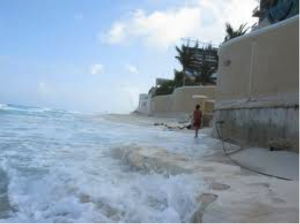
Figure 5. Cancun seawalls cause beach erosion, causing endless cycles of sand dumping, all of which washes away again (Google images)
Cartagena, Colombia, where I was a few days ago, is a similar case. Unlike Cancun, a recent development that did not exist 40 years ago, Cartagena is one of the oldest Spanish cities in the Americas, built to protect the Spanish treasure fleets en route to Portobelo, Panama and Veracruz, Mexico to steal the gold and silver from the ancient Indian civilizations of Peru and Mexico. In Cartagena, Portobelo, and Veracruz they built massive forts out of limestone rock (Figure 6).
Some of this rock was quarried by Indian and then African slaves from fossil reefs now exposed on land, that grew the last time global temperatures were 1 degree warmer than today, and sea levels were 7 meters (25 feet) higher than they are now. But much of it came from pulling living corals out of the reef and cementing it in lime mortar cement, made from burning more corals (Figures 7-8).
Of course, after destroying the living reef that had protected the beach and constantly generated new sand, they lost their beaches. Now they have erected huge hotels on top of sand spits, centimeters above sea level (Figure 9).
500 years ago, when the forts were first built, sea level was stable, but with the steady sea level rise caused by carbon dioxide from fossil fuel combustion, now with every high tide the cars have to drive through sea water on the coastal roads, and the foundations of the high rise hotels are being corroded by salt. With the accelerating sea level rise that will soon come, these buildings will soon be in the water. Yet there is no end to the building of new hotels: massive construction is underway everywhere along the beaches, thanks to the endless flow of money from North America and Europe into the Colombian economy, money that is “laundered” by turning it into tangible property assets.
The beaches in front of the main hotel zone at Boca Grande now are little pitiful bits of sand sandwiched between rock walls, or espolones, that block the flow of sand along the shore from east to west, so that each hotel is busy stealing the sand from their neighbors, and all are losing. As one would expect, these rock walls cause scouring and erosion, so they actually dig their own graves, sinking downward as sand is washed away, and constantly needing to be rebuilt. They are massive failures, and vast sums have been wasted with little or no result.
Across the road from the high-rise hotels now being built east of the old walled city of Cartagena, Mangrove swamps line the lagoon. There is a thin fringe of mangrove trees to hide what lies behind from the view of the tourists, but immediately behind are slums, populated by descendants of the African slaves who built the walls of the old city. They live in the heart of the swamps in shacks built from scavenged boards and galvanized iron sheets, wading through the water at the high tide, and enduring the rotten egg stink of the mangrove mud and decomposing garbage when the tide falls. The swamp people are marginalized economically, one sees few black faces in the tourist zones, most of the street peddlers are mestizo immigrants from the highlands. The swamp dwellers, who have no place to run but the swamps, because property speculators raise the price of dry land, are the first victims of sea level rise. No photographs of the fetid slums in the mangrove swamps can be found on Google Images, showing how effectively their existence is ignored or concealed.
The same absurd cycle of building by rich and poor alike in places that will soon be underwater is repeated in every low lying tourism development zone in the world, except in a handful of places, like the Turks and Caicos Islands, that ban building right on the shore by strictly enforced requirements that hotels maintain natural beaches and build only well behind the vegetation line.
In the early 1970s I attended a lecture by the distinguished geologist and beach erosion expert, Orrin Pilkey. He was in fine form, inveighing against idiots who built castle-like mansions right on eroding shorelines, and then demanded that the government spends taxpayers’ money to build walls in front of them so they don’t collapse into the sea. A member of the audience, a well-known geologist, interrupted, saying “wait a minute, people don’t build ON the shoreline, they build behind it and then the shoreline moves”. Pilkey simply said “next slide” and proceeded to show photo after photo of houses actually constructed on and above the shoreline, all collapsing into the sea. At that time global sea level rise was not well established, because existing tide gauge records were inadequate to statistically prove that ocean levels were rising globally. It was then thought that some shores were eroding, and others were growing, with a net balance, and that people were simply fatally attracted to building on unstable sand spits, which any geologist could tell them were dynamic and mobile features that migrated with every major storm. Since then, global satellite radar data has conclusively measured sea level rise in every part of the ocean. There are regional differences to be sure, with some areas rising faster than others as ocean circulation changes due to changes in global sea surface temperature and atmospheric pressure caused by global warming, but the satellite data shows that the global rate of sea level rise has increased in the last decades, and it is certain that it will greatly accelerate in the years to come.
Other cities built along low lying coasts all over the world are in the same boat, avoiding long term action in the hope that if ignored, the problem will simply vanish. London, Venice, St. Petersburg (both the one in Russia and the one near Tampa, Florida), New York, Miami, Alexandria, Lagos, Abidjan, Bangkok, Jakarta, Saigon, Shanghai, Dhaka, Bombay, Calcutta, Madras, Karachi, are only a few of them. Perhaps a billion people will be forced to move if global warming and sea level rise is not reversed. You would have to be mad to buy land in South Florida (“mad” in the good old English meaning of the word as crazy or insane, not in the American misuse of the word to mean angry or upset). The last time global temperatures were 1 degree warmer than today all the major cities of South Florida were underwater, and the shoreline was more than two hundred kilometers inland from where it is now, north of Lake Okeechobee.
No one is preparing for the climate change refugees who will soon be abandoning their homes, migrating inland, heading for higher ground wherever they can find a bit of space that has not already been occupied, causing massive social and economic dislocation. The worst hit will be the low lying island dwellers who will lose their entire islands and even countries, who have nowhere to move without losing their entire cultures and migrating to live surrounded by strange people who will not appreciate these intruders. The Maldives, Tuvalu, Kiribati, the Marshall Islands are countries that will vanish if the world does not immediately reverse global warming. Every single one of their islands has a serious erosion problem. I have been to all of these countries, yet there is no meaningful action to protect their islands other than dumping rocks and concrete in the sea after it is too late. Few of their people will even admit what is happening to them, they think the problem will go away by itself, that every time a tree falls into the sea, a house collapses, a road is washed away, a wave crosses their island and kills their crops with salt, that it is a unique event that will never happen again.
Peter Rudiak-Gould, in his book, The Fallen Palm, recalls asking Marshall Island atoll dwellers why this tree fell into the sea, or why those graves of their ancestors have washed into the sea, getting answers like “it must have been the wind”. These events are rationalized as isolated incidents, not a recurrent and accelerating pattern. Many people on Pacific Atolls are unconcerned, because they only know of one book, and they are told every Sunday in their churches about a hairy alarmist named Noah, who built a boat and saved only his family and animals when their god drowned the whole world and all the rest of its peoples, and that afterwards their god promised he would never, ever, do it again! They feel they have a divine guarantee forever that sea level rise over their islands can’t ever possibly happen, so there is no reason to worry, even though only two years ago thousands of Marshallese were forced from their homes by high tides and there was a national state of emergency declared!
Some of the people who are already becoming climate change refugees are the Kuna Indians of Panama, lobster divers who live on tiny islands in the sea that they have built up over the centuries by pulling corals out of the sea. The Kuna are one of the most remarkable cultures in the world, they are just about the only Native American culture that never lost their land, culture, or political institutions because they successfully kept outside colonizers away, and they are unique in their confidence and love of knowledge. The Welsh pirate, Lionel Wafer, who was marooned in Kuna Yala in 1680 following the sacking of Cartagena, first brought the Kuna to the world’s attention. He described with astonishment a people who had no kings or rulers, where every person was respected according to their knowledge and the degree to which they could articulate it in nightly discussion meetings, people who elected their chiefs for their wisdom and eloquence, and that these offices were not hereditary, the opposite of Europe at the time. It was Kuna culture that produced the notion of a perfect participatory democracy with no ruling class exploiting the rest, which provided the inspiration for the “noble savage” ideal that stimulated Rousseau and Voltaire and led to the French Revolution. These ideals remain in Kuna Yala, but they have the wisdom to know that they must also pick the best of modern knowledge and adapt it to their needs, while preserving their traditional culture. My late aunt, Berta Arango de Urriola, was the Panamanian Minister of Education who established the government schools in Kuna Yala, and she was gratified to see how the Kunas took to education, so that they know have the highest educational level of any group in Panama. The Kunas made her an honorary chief, or Sahila, in return.
When there were many corals and few people, the effects of coral mining were minor, but global warming has now killed most of their corals, and now their islands are packed full of people. The Kuna village I have worked with since 1994, Ukupseni (Figure 10), is on an island about 100 meters wide and 200 meters long, but has around 4,000 people. All Kuna islands have serious erosion problems due to global sea level rise. Many of the villages have decided that their situation is now hopeless, that they have no choice but to abandon their ancestral islands and move to the mainland. A few weeks ago I met with the head Cacique, the chief of all the chiefs of Kuna Yala, and he assured me that they will support whatever they need to do to protect their islands and coral reefs.
Global sea level rise is a crisis that will affect the rich and the poor, but most of all the poorest. The Marshall Island Atoll Islanders that I lived with 2010, building shore protection projects powered by wind, sun, tidal currents, and wave energy, make around $200 a year. Yet they live surrounded by vast amounts of sustainable energy, and they would need to tap only a tiny fraction of it to grow coral reefs and grow their eroded beaches back, just as we have done in the Maldives and Indonesia (Figure 11):
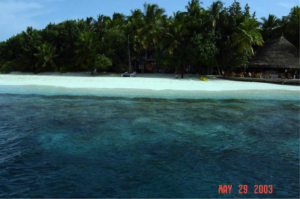
Figure 11. New Beach grown in two years at Ihuru Island, North Male Atoll, the Maldives, at a location where the beach had eroded away and the building on the right was about to collapse into the sea at the start of the project. The Biorock shore protection reef is the dark line in front of the beach. The Asian Tsunami passed right over this island without causing any damage to beach or reef. Photo by Azeez Hakeem.
Grim as the situation is, the solutions are at hand and proven, but there is no will among policy makers or the international funding agencies to use what we already know in order to adapt to global climate change and to reverse it. If these fools do not stop wasting resources on building castles on the sand, investing in fools’ paradises, and denying what is happening, they will destroy the capacity of the planet’s life support system for future generations, because they are simply stealing from their own grandchildren.
Please look at the links embedded in the article link below for more information on why the issue is far worse than they realize, and why the solutions are well known but just not being used due to ignorance, greed, and stupidity of clowns who have absolutely no excuse for not knowing better.
Coral reefs are doomed in a few years because governments failed to reverse global warming in Cancun
